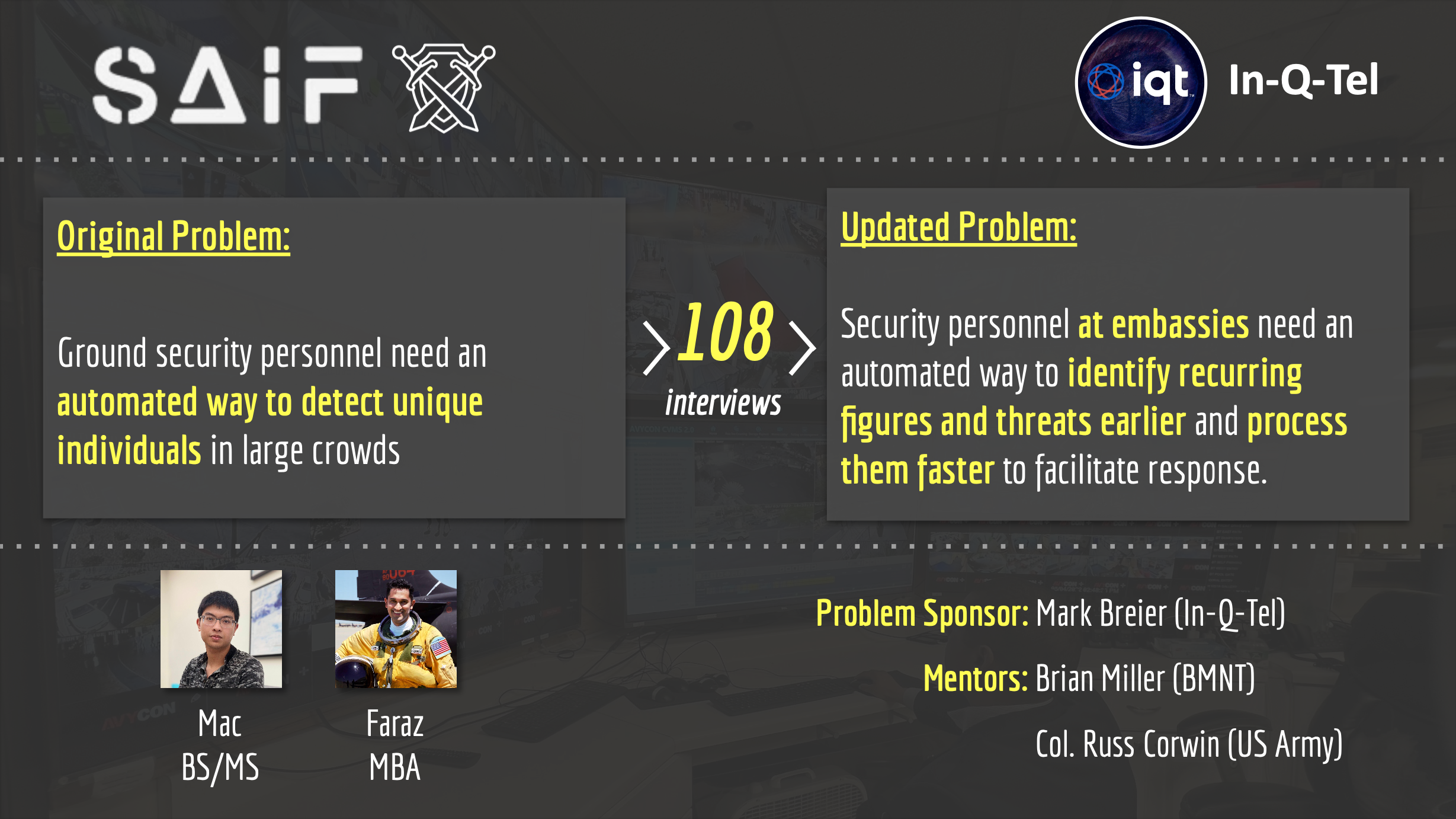Team SAIF
A New Vision for the Future of Physical Security
The Team
Syed Faraz
• MBA, Stanford (2023)
• MPA, Harvard
• BS in Economics and Political Science, UT Arlington
Mac Klinkachorn
• MS in Computer Science, Stanford
• BS in Physics and Computer Science, Stanford
Problem Sponsor
Mark Breier, Partner, In-Q-Tel
Original Problem Statement
Ground security personnel need an automated way to detect unique individuals in large crowds.
Beneficiary Discovery Interviews
108
The Innovation
Department of State embassy security personnel face numerous challenges particularly when it comes to large crowds. A student team in the Spring 2002 Stanford University Hacking for Defense course investigated this problem and focused a Minimum Viable Product (MVP) on identifying suspicious individuals within large crowds. After successfully completing the course, the team began working on developing a dual-use product to increase safety on school and university campuses.
The SAIF team was formed in the Spring 2022 term of Stanford’s Hacking for Defense course. The original team was composed of Mac Klinkachorn, Eric Frankel, Syed Faraz, Savannah Ardrey, and Katherine Miller – a diverse group of undergraduate and graduate students from a multitude of backgrounds including computer science, business, and defense.
The team was originally tasked with addressing the issue of identifying unique individuals in large crowds where existing facial-recognition technology was not applicable. However, after conducting 108 beneficiary discovery interviews, the team realized that their original problem statement was too general and focused their efforts on improving security around high-risk locations.
During the semester, Team SAIF zeroed in on providing security personnel at embassies an automated way to identify recurring figures and threats earlier in order to facilitate faster response. The team noted that senior officials recognized challenges surrounding security at these locations, specifically that malicious actors often reconnoiter and surveil locations long before an attack. From there, they developed a mission-control AI product with a force multiplier tool for security officers to help them automatically flag potential security threats. They also developed a video search tool for security teams. Beneficiaries told the team that their proposed technology could “prevent Benghazi from ever happening again.” After the conclusion of the course, the team has shifted their focus from embassy security to school security.
Currently, Team SAIF has developed three further MVPs. One is a mobile version of the mission-control product, the second a redaction tool which uses AI to automatically redact Personal Identifiable Information (PII). The third MVP is an information extraction tool which can automatically pull relevant details from videos.
During their time in the Hacking for Defense course, the team was able to verify the need for these products. However, as the term came to a close, the technology and a fully functional prototype was not yet ready. Team SAIF was awarded a CMP Impact Grant supported by Lockheed Martin to aid them in moving forward with developing their product.
Presentation
Team SAIF’s Hacking for Defense Experience
Faraz is an accomplished Air Force Navigator who has worked in defense innovation for seven years. He was first exposed to the Hacking for Defense program when a squadron on his base worked with an H4D team (Team Learn 2 Win). He was able to learn about H4D on a much more personal level, and when applying for business schools, Stanford was his number one option because of its proximity to Steve Blank. Faraz describes Blank as “a legend in the defense innovation space. I wanted to attend Stanford and specifically take the Hacking for Defense course in order to learn from the man behind the Lean Launchpad methodology.” Faraz’s favorite part of his H4D experience was when Team SAIF traveled to San Diego to work with stakeholders and sponsors at InQtel. “We were the only student team invited by InQtel in the last decade, which was a really cool experience,” he says, demonstrating the success, viability, and potential of Team SAIF’s MVPs.




